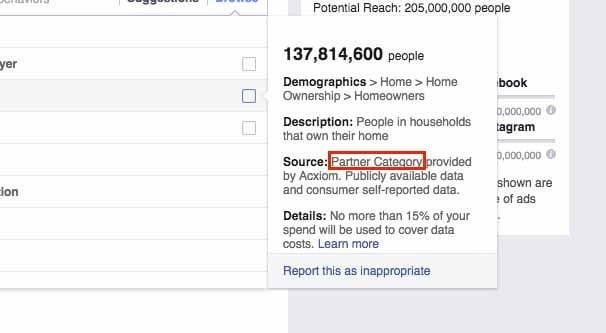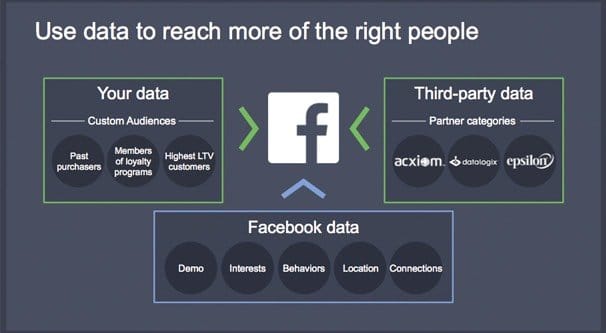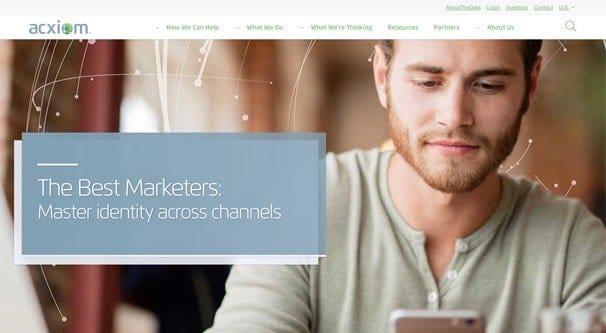 Written by ContentPowered.com
Written by ContentPowered.com
Facebook has approximately ten thousand different ad targeting options you can use, depending on a whole lot of different factors. You have all of the obvious options, like age, gender, and location. You have trickier options like connections to influencers and commonality for likes. You have lookalike audiences and copycat audiences. And, of course, you have other elements like income targeting.
Special Targeting Factors
Facebook has a special set of restrictions on some kinds of targeting options. These are targeting options they categorize as “Partner Categories.” When you create an ad and when you set your targeting options, you can see certain specific types of detailed targeting options and their parameters. An example Facebook uses is home ownership status. When you choose a specific category, you see what subcategory it is (like demographics > home > home ownership > homeowners) and the description of that targeting option. You can also see details of the option and, most importantly, the source of the data.
When you’re using a targeting option that has a source labeled “partner category” you’re getting data from one of Facebook’s third party partners. In other words, it’s data you have access to because someone else sold that data to Facebook in a large database.
What, you didn’t think Facebook harvested everything, did you? God, no. Facebook has a ton of personal information, but I don’t know about you, I’ve never put my income level into Facebook. They have no idea how much I make based on my posts or my likes. I’m not in any groups meant for specific income ranges, or anything like that.
No, generally there will be an entry like “Source: Partner Category provided by Acxiom. Publicly available data and consumer self-reported data.” The exact information will vary; the company providing it might be different, and whether or not the data is self-reported will be different.
Acxiom, for the record, is an IT service management company that specializes in data analysis and harvesting. The data they collect, collate, and analyze is passed on to their business clients, like Facebook. Facebook pays a lot to have access to that information, and you in turn pay to be able to target users based on that information. Facebook discloses what companies they work with, actually; their partners are Acxiom, Acxiom Japan, CCC Marketing, Epsilon, Experian, Oracle Data Cloud, and Quantium.
Partner categories are, importantly, only available in specific areas. Acxiom provides data from Australia, France, Germany, the US, the UK, and Japan. CCC Marketing provides data from Japan. Epsilon provides data from the US. Experian provides data from Australia, Brazil, the UK, and the US. Oracle provides data from the UK and the US, and Quantium provides data from Australia.
Partner categories have two major restrictions. One is location, as mentioned above. If Facebook doesn’t have access to data about users in your country, you can’t target that information in that country. You also can’t access partner category information from outside that area. Crucially, if the information is only available in the US, and you’re a UK agency, you can’t access it. This is true even if your targeting is restricted to the US and if your client is in the US. You have to actually be based in the US to access this US marketing data.
This is true primarily to make it easier for Facebook to track data restrictions. Data sale and privacy laws vary from location to location, and selling information across country borders is a massive hassle. Rather than deal with it, Facebook restricts it.
There’s one more quirk of partner category data; since it costs Facebook to obtain, Facebook tweaks costs to cover their expenses. Up to 15% of your total ad bid will be redirected to the cost of the data you’re using. That means if you’re spending $100 on ads, you’re actually only spending $85 on ads; the other $15 goes off to Axciom or whoever to cover the cost of accessing the data.
Facebook does say this fee varies and that the 15% is a maximum reduction, so you might only see 2% or 5% reduction, or somewhere else in the middle. It’s worth noting, however, that to get the same reach and the same ad bids, you need a higher total budget to cover the cost of partner category data.
Is Income a Partner Category?
This is a good question. I don’t actually know if income is a partner category or not. According to this help center thread, initially posted and answered two years ago, income is a partner category. People in the UK were not able to access income data from people in the US, and thus were unable to target US users by income.
However, using my ads account right now – which is based in the US – I can access income targeting. It does not show a source as a partner category, which implies one of two things. Either the data is local so Facebook does not feel the need to disclose the fact that it’s from a partner, or it’s no longer partner category data. I have no way of knowing or testing which it is.
I would assume that income is either no longer a partner category or is only accessible in a geographically local region. I believe the former is true; broad income targeting is available to anyone, but some more specific income targeting information is still a partner category.
Types of Income Targeting
In order to access income targeting, you need to create a new ad campaign with a new ad objective, which can be whatever you want it to be. Then, at the ad set level, you can click on the Audience section. There will be a lot of options here, to create a new audience or use a saved audience. Create a new one. You can specify whatever location, age range, gender, languages, and whatnot you want.
Under the Detailed Targeting section, there’s a text box you can search, or browse through drop-downs. What you’re looking for is the demographics drop-down, and under that the Financial drop-down. Inside that are two options: Income and Net Worth. Additionally, under Net Worth is another option, Liquid Assets.
Your options under Income are various ranges. These are from 30K to 40K, from 40K to 50K, from 50K to 75K, from 75K to 100K, from 100K to 125K, from 125K to 150K, from 150K to 250K, from 250K to 350K, from 350K to 500K, and over 500K. All of these ranges have an estimate of the number of people in the audience based on your other targeting options. For example, with base settings in the USA, ages 18-35, all genders and no language restrictions, Facebook will make the 30-40K range target 14 million people. The over 500K demographic slice is 1.2 million people. The largest slice is the 50-75K range, which is just under 41 million people.
Obviously there are a lot more people in the USA who make that kind of income range, but not all of them are on Facebook or have data available through Facebook’s source.
If you choose Net Worth, this is where you start to see that it’s Partner Category data. In this case, Net Worth and Liquid Asset information is partner category information provided by Acxiom, modeled based on age, income, presence of children, occupation, property data, vehicle data, investment interest, and census media data.
In other words, the data may be inaccurate due to Facebook getting modeled data. The data is estimates based on factors, rather than actual reported or recorded data. I might make a lot more than they think I make, but based on few investments, a cheap car, and renting rather than owning property, they might think I make less. However, when your sample size is in the tens of millions, your estimates tend to be relatively accurate.
The categories for Net Worth are ranges from $1 to $100K, 100K to 200K, 200K to 500K, 500K to 750K, 750K to 1M, 1M to 2M, and over 2M.
As far as Liquid Assets are concerned, it’s also modeled data, and the ranges are from $1 to 25K, 25K to 50K, 50K to 100K, 100K to 250K, 250K to 500K, 500K to 1M, 1M to 2M, 2M to 3M, and over 3M.
All income data, at least for the USA, comes from Acxiom.
As a test, it seems like foreign data is now accessible and is not partner data, at least for basic income information. My US-based account is able to target Japan residents with specific income ranges, though the numbers are much smaller. All of Japan, age 18-65+, all genders and no other restrictions, with the income range 75K to 100K USD, is an audience of 5,600 people, estimated.
Is Facebook Income Targeting Worthwhile?
First of all, I have to warn you that Facebook’s income data is not perfectly accurate. The data is modeled based on various factors, correlated with other data, and matched against Facebook users who fit those categories. It’s entirely possible that Facebook’s algorithms are inaccurate or broad, so you might not be entirely reaching the exact income ranges you want. Now, with massive sample sizes, you’re going to get a lot of accurate targeting, it’s just fringe people you might not properly reach. Unless you’re paying for 100% saturation of your audience, it probably won’t come up.
Is it worth it to target people of certain income or asset levels? That depends entirely on what you’re selling, I suppose. If you’re a specialty yacht manufacturer, I can pretty much guarantee you no one under the 1 million mark is going to even look at your ads unless they’re screenshotting them to laugh at. If you’re selling some low-end budget version of a smartphone, you might do well to target people of the lower income brackets who are more likely to buy a Hauwei than a Samsung.
For most general interest products, however, income targeting is at most a supplemental option. You can target anyone you like with a real estate listing, so long as they might be able to afford the listing. It’s likely more effective to target geographically local people or people interested in moving than it is to target people of a certain income bracket.
My opinion is that, yes, income targeting can be a valuable addition to your advertising. However, this requires you to know what kind of people and what income levels are most likely to be buying your products, and it assumes that you’re already using other targeting options to narrow down your audience. It does you no good to target anyone 30-50K in annual income if you’re targeting literally the entire world. Use some geographic targeting, some demographic targeting, and income targeting to further refine your audience. With all of it layered on top of one another, you’ll have a smaller, more manageable audience and you’ll be able to reach more of them with lower costs.
Just don’t try to use income targeting as your primary source of audience definition. As I said, the information is not complete and it is largely estimated, so while it will be mostly accurate, it won’t be as valuable on its own.




